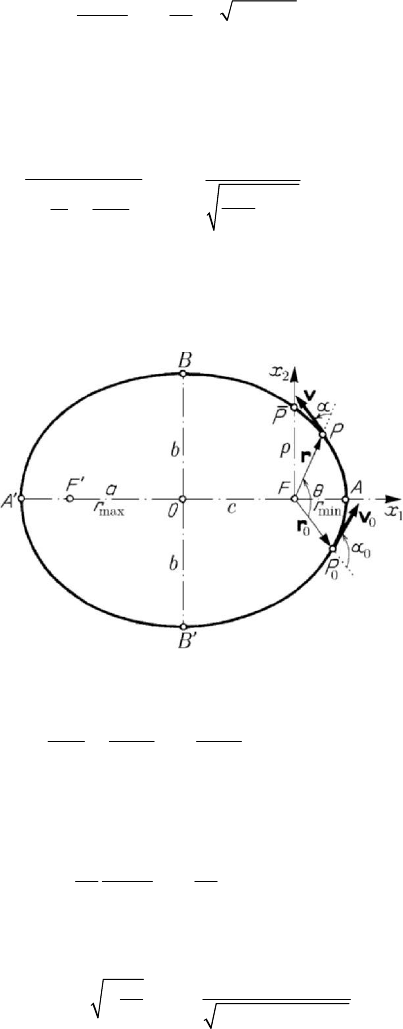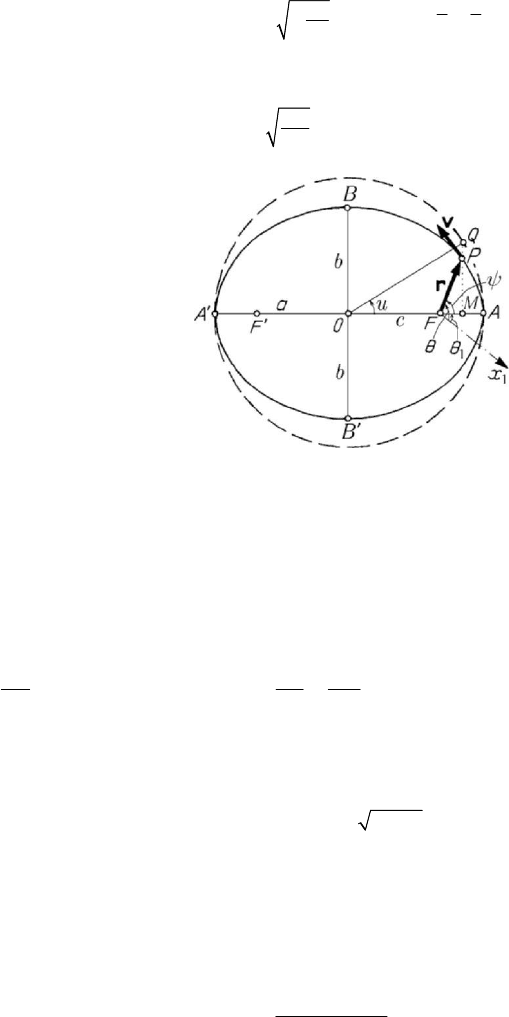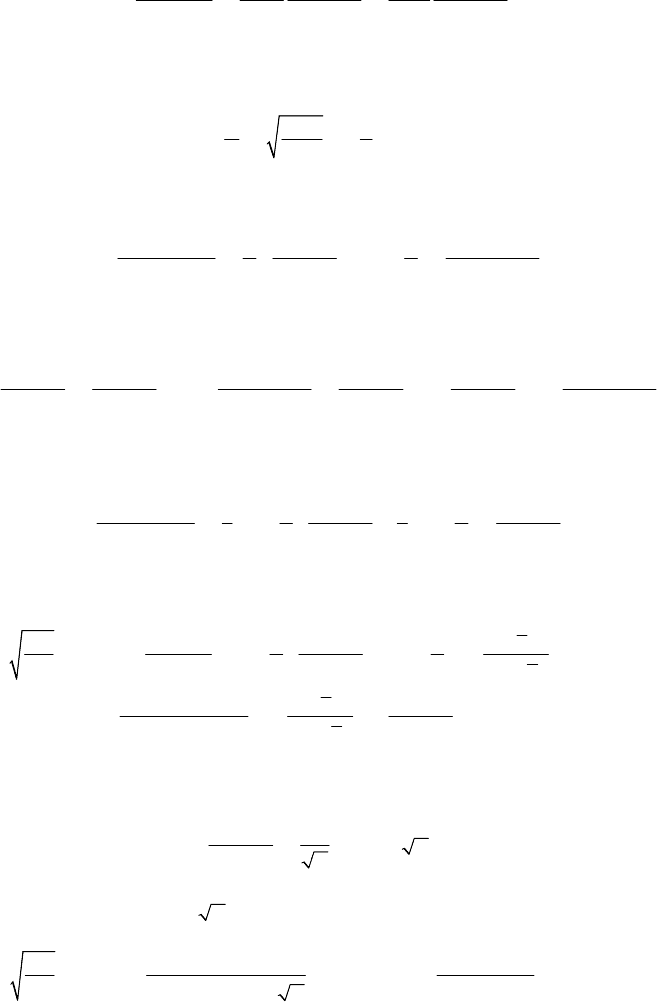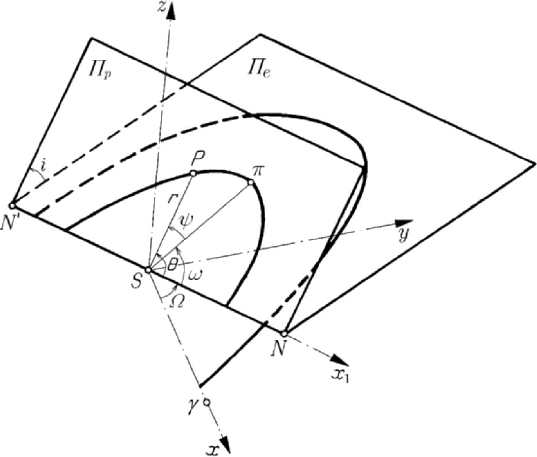Teodorescu P.P. Mechanical Systems, Classical Models Volume I: Particle Mechanics
Подождите немного. Документ загружается.


MECHANICAL SYSTEMS, CLASSICAL MODELS
562
which are not independent (we may have at the most six independent first integrals for a
single particle). Observing the scalar product
0
O
⋅
=KR (two zero mixed products),
it results that the Runge-Lenz vector, applied at the pole
O of attraction, is contained in
the plane of the motion (because
O
⊥
KR ,
const
O
=
J
JJJJG
K
). Using the two previous first
integrals, we can write (
O
⊥
rK
)
(
)
222
2
() 2
OO
f
mM
mC h
r
×= = +
rK rK ;
it results then (
2
()()
OOO
mmK×⋅=×⋅=
rK r rrK
)
(
)
2
2222
()2()
OOO
f
mM fmM f m M
rr
×− =× − × ⋅+
rr
rK rK rK
(
)
2 22 222 2 222
22 2
f
mM M
mC h f mC fmM mCh fmM
rr
=+− +=+
,
so that
f
mMe
=
R ,
(9.2.11')
where we have introduced the eccentricity (9.2.5) (
kfmM
=
). Choosing the
1
Ox -axis
along the Runge-Lenz vector and denoting
(,)θ
=
) rR , we may write
cosr θ⋅=rRR ; as well, ()
O
f
mMr
⋅
=× ⋅−
rrK r
R
2
/
O
KmfmMr=−
2
mC=
f
mMr− . Equating the two expressions of the scalar product and taking into
account (9.2.7), (9.2.11'), we find again the equation (9.1.1) of the conic. The Runge-
Lenz vector allows thus to determine the equation of the trajectory on an algebraically
way, its direction being from the centre of attraction to the pericentre.
2.1.3 Elliptic motion. Kepler’s equation
If
0h <
, then the trajectory of the particle acted upon by a force of Newtonian
attraction (we can have only
0k >
, e.g., kfmM
=
) is an ellipse; in the elliptic motion
we write the equation (9.2.5') in the form
(
)
22 2 2
12 1
12ex x pex p−++= (we have
01e≤<). We notice that we may write this equation also in the form
2
2
1
2
22
()
1
xae
x
ab
+
+
= ;
(9.2.12)
the semiaxes (Fig.9.7)
2
2
1
pk
a
h
e
==−
−
,
2
2
1
pm
bC
h
e
==−
−
(9.2.12')
and the focal distance

Newtonian theory of universal attraction
563
22
2
2
1
pe ke
cae a b
h
e
== =−= −
−
(9.2.12'')
are thus put in evidence. We mention that, for a given potential (
k is given), the semi-
major axis of the ellipse depends only on the mechanical energy constant
h . We may
express the semiaxes of the ellipse by means of the initial conditions in the form
2
0
0
1
1
2
2
a
mv
rk
=
⎛⎞
−
⎜⎟
⎝⎠
,
00 0
2
0
0
sin
2
rv
b
k
v
mr
α
=
−
;
(9.2.12''')
thus, we notice that
a does not depend on the direction of the initial velocity (Fig.9.7).
From (9.2.12') it results that the conservation theorem of mechanical energy may be
written in the remarkable form
Figure 9.7. Elliptic motion due to the potential () /Ur k r
=
.
2
22
mv fmM fmM
ra
−=−
.
(9.2.12
iv
)
To can determine the law of motion along the ellipse, we use the equation (9.2.10).
From (9.1.1') and (9.2.12'), it results
2kah=− ,
()
2
222
2
22
1
1
hp h
Cae
mm
e
=− =− −
−
,
min
(1 )rae
=
− ,
so that
0
22 2
(1 )
d
2
()
r
ea
m
tt
h
ae a
ρρ
ρ
−
=+−
−−
∫
;
by a change of variable
(1 cos )aeuρ =− , we may write

MECHANICAL SYSTEMS, CLASSICAL MODELS
564
0
0
(1 cos )d
2
u
m
tt a e uu
h
=+ − −
∫
,
wherefrom we get Kepler’s equation
0
(sin)
ma
tt a ue u
k
=+ − .
(9.2.13)
Figure 9.8. Elliptic motion in Kepler’s representation.
We assume now that, in general, the
1
Fx -axis does not coincide with the apsidal line
(
1
0θ ≠ , Fig.9.8),
1
ψθθ=− being the true anomaly. The equation of the conic takes
the form
(
)
222
(1 cos ) / /re pbaacaaceψ+===−=−, where we used the
notations (9.1.2), (9.1.2''); if we take into account the above change of variable, then we
have
cos ( )/ coscr area uψ+=−=. The ordinate of the point
P
meets the
director circle of the ellipse at
Q ; if
n
uQOF= , then we notice that
cos cosOQ u a u= is given by cosOF FM c r ψ+=+ , hence just the expression
obtained above. The angle
u has thus a simple geometric interpretation and is called
eccentric anomaly. The Cartesian co-ordinates of the ellipse are easily obtained in the
form (with respect to the axes in Fig.9.7)
1
(cos )xa ue=−,
2
2
1sinxa e u=− ,
(9.2.14)
where we took into account the relations
(1 cos )ra e u=− , cos cosaucrψ
=
+ .
(9.2.14')
One gets also
cos
cos
(1 cos )
auc
aeu
ψ
−
=
−
;
(9.2.14'')
observing that

Newtonian theory of universal attraction
565
1cos 1cos 1 1cos
1 cos 1 cos 1 1 cos
ac u e u
ac u e u
ψ
ψ
−+−+−
==
+−+−+
,
we obtain, finally, the relation which links the eccentric anomaly to the true anomaly in
the form
1
tan tan
21 2
eu
e
ψ +
=
−
.
(9.2.15)
Considering the equation (9.2.9'), we may write (
0γ
≠
)
(
)
() ()
2
22 2
22
1d
dd
11
1
1
11
ηη
ηη
γγ
γη
γη γη
+
⎛⎞
=+−
⎜⎟
+
⎝⎠
++
∫∫ ∫
;
an integration by parts leads to
() ()
2
22 22 2 2
22
dddd
222
11 1 1
11
ηη ηη η η η
γ
γη γη γη γη
γη γη
=+ =+ −
++ + +
++
∫∫ ∫∫
,
so that, finally, we have
(
)
()
2
22 2
2
1d
d
11 11
11
22
11
1
ηη
ηη
γγ
γη γη
γη
+
⎛⎞ ⎛⎞
=− ++
⎜⎟ ⎜⎟
++
⎝⎠ ⎝⎠
+
∫∫
.
Thus, the equation (9.2.9') can be integrated in the form
0
322 2
0
d
11 1
() 1 1
(1 ) 1 1
fM
tt
pe
η
ηη
γγ
γη γη
⎡
⎤
⎛⎞ ⎛⎞
−= − ++
⎜⎟ ⎜⎟
⎢
⎥
++ +
⎝⎠ ⎝⎠
⎣
⎦
∫
()
222
0
d
2
(1 ) 1 1 1
e
ee
η
ηη
γη γη
⎛⎞
=−
⎜⎟
+− + +
⎝⎠
∫
.
(9.2.16)
We notice that
01e≤<
, so that
01γ
<
≤
; it results
()
2
d
1
arctan
1
η
γη
γ
γη
=
+
∫
.
By the change of variable
tan( / 2)uγη
=
, we find the equation
()
()
0
32
3/2
2
11
( ) ( sin ) (1 sin )
(1 ) 1
1
f
M
tt ue u e u
pee
e
γ
−= − = −
+−
−
,
equivalent to Kepler’s equation (9.2.13).

MECHANICAL SYSTEMS, CLASSICAL MODELS
566
The particular case of circular motion (
0e
=
) has been considered in the preceding
subsection; Kepler’s equation (9.2.13) puts thus in evidence a uniform motion.
2.1.4 Keplerian motion. Kepler’s laws
In the case in which the centre of attraction
S of mass M , considered to be fixed, is
the Sun, the particle in motion (with respect to the centre
S ) being a planet P , we
have to do with the solar system. Analogously, one may consider the motion of a
satellite of a planet with respect to that one, e.g., the motion of the Moon with respect to
the Earth. We are in the case of the elliptic motion, considered above. Kepler’s laws,
enounced in Subsec. 1.1.1 as a synthesis of astronomical observations, are obtained
now as a mathematical consequence of the Newtonian model of the considered
mechanical system. The results thus obtained allow us to state
Theorem 9.2.1 (Kepler, I). The motion of a planet around the Sun is an elliptic one, the
Sun being at one of the foci.
Theorem 9.2.2 (Kepler, II; the law of areas). In the motion of a planet around the Sun,
the radius vector of it describes equal areas in equal times.
In celestial mechanics, the notation
33
kfM
n
ma a
==
(9.2.17)
is used, so that Kepler’s equation may be written in the form
0
sin ( )ue u ntt
−
=−.
(9.2.13')
We notice that to a variation
2π of the true anomaly there corresponds the same
variation of the eccentric anomaly
u . Kepler’s equation (9.2.13') leads to the period T
in which the planet
P travels through the whole ellipse, hence effects a motion of
revolution (the radius vector describes the whole area of the ellipse) in the form
2
2
a
Ta
nfM
π
π==
;
(9.2.17')
it results that
n represents the circular frequency (called the mean motion too). We
may also write
22
3
4T
f
M
a
π
=
(9.2.17'')
stating thus (the ratio
2
4/
f
Mπ
depends only on the mass of the Sun)
Theorem 9.2.3 (Kepler, III). In the motion of planets around the Sun, the ratio of the
square of the revolution time to the cube of the semi-major axis is the same for all
planets.
The eccentricity
e of the orbits of the nine planets of the solar system (recently, a
tenth planet has been discovered) is, in general, very small as it results from the

Newtonian theory of universal attraction
567
mean
30 km/sv ≅ ). For the Moon, satellite of the Earth, we can make analogous
observations, the corresponding eccentricity being
0.066e
=
; the point of the orbit
which is the closest to the Earth is called perigee, while the point which is the most
distant is called apogee.
Table 9.1
Planet e
Planet e
Planet e
Mercury 0.2056 Mars 0.0933 Uranus 0.0471
Venus 0.0068 Jupiter 0.0484 Neptune 0.00855
Earth 0.0167 Saturn 0.0558 Pluto 0.2486
During the time, it was stated, by astronomical observations, with perfectionate
instruments, that the theorems enounced above correspond to the reality only with a
certain approximation. For instance, by the above calculation, one has obtained a
immobile perihelion, while the observations put into evidence a displacement of this
point of the planetary orbit, displacement which is more sensible for a planet close to
the Sun, which has a great eccentricity; especially, Mercury has a secular displacement
of
43.5'' of its perihelion, which has been put in evidence in 1859 by U.-J.-J. Leverrier.
To eliminate the non-correspondence between the theory and the observation, an
improvement of the mathematical model of Newtonian attraction law has been
attempted, by introducing an additional term or an exponent other than 2 at the
denominator; as well, it has been admitted the existence of a planet not discovered yet.
In this order of ideas, Weber modelled the phenomenon by introducing a non-
conservative force of universal attraction of the form
()
2
2
1
12
W
rrr
c
⎡⎤
=− +
⎢⎥
⎣⎦
FF, constc
=
,
(9.2.18)
but did not obtain satisfactory results concerning the deviation of Mercury’s perihelion.
Analogously, G. Armellini proposed a law of the form
[
]
1
A
rε=+FF, constε
=
, (9.2.18')
to may explain the existence of circular orbits. In both cases,
F is a force of Newtonian
attraction given by (9.1.7), (9.1.7'). But these non-concordances could be eliminated
only in the frame of a non-classical model of mechanics: the relativistic model.
Table 9.1, in which the planets are put in the order of the distances to the Sun. We
notice thus that, excepting Mercury and Pluto, the planets at the smallest and at the
greatest distance to the Sun, respectively, the other planets (the Earth included) have an
almost circular orbit; the closest to a circular is the orbit of Venus. The pericentre of the
orbit is called perihelion (denoted by
π ), while the apocentre is called aphelion
(denoted by
α ). Corresponding to the Theorem 9.2.2, a planet has the maximal velocity
at the perihelion and the minimal one at the aphelion; between those points the velocity
has a monotone variation. For instance, the Earth has the velocity
30.27 km/sv
π
=
at
the perihelion and the velocity
29.27 km/sv
α
=
at the aphelion (we take

MECHANICAL SYSTEMS, CLASSICAL MODELS
568
The elliptic motion of a planet is defined in space by six parameters, called the
elements of the elliptic motion. Using an ecliptic heliocentric frame, we take as
reference plane the ecliptic plane
e
Π (which contains the orbit of the Earth), denoted as
the
Sxy -plane (SF≡ ). The Sx -axis passes through the first point of Aries (the
vernal point)
γ (on the celestial sphere of radius equal to unity, at the intersection of a
plane parallel to the equatorial plane of the Earth, passing through the centre of mass of
the Sun, and the ecliptic plane), corresponding to the spring equinox, while the
Sy -axis
passes, e.g., through the point corresponding to the summer solstice; the
Sz -axis is
directed towards the boreal pole of the ecliptic. The plane
p
Π of the planet P orbit
intersects the ecliptic plane at the line of nodes
NN
′
( N and N
′
are on the celestial
Figure 9.9. Elements of the elliptic motion of a planet.
sphere;
N is the ascending node from which z passes from negative values to positive
ones, while
N
′
is the descending node from which z passes from positive values to
negative ones); this plane is specified by the angle
n
SNγΩ
=
, called the longitude of
ascending node, and by its inclination
i with respect to the ecliptic plane (Fig.9.9).
Choosing
SN as
1
Sx -axis, we may specify the point π by
n
1
NSπωθ== (the
argument of perihelion); the angle
Ωω
+
(obtained by summing two angles in
different planes) is called the longitude of perihelion. The position of the ellipse is thus
given in its plane. The magnitude of the orbit is then put in evidence by the semi-major
axis
a and the eccentricity e . Finally, the motion along the ellipse is characterized by
the period
2/Tnπ= (the period of the revolution motion) and by the moment
0
tt
π
= (the moment at which the planet P passes through the perihelion). Hence, the

Newtonian theory of universal attraction
569
elements of the elliptic motion are
,, , ,iaeΩω
and t
π
; these six elements may be
determined by measuring three directions from the Earth to the planet
P , from three
successive locations on the ecliptic.
We return now to Kepler’s equation (9.2.13'), written in the form
sinue u τ−=,
0
()nt tτ
=
− ,
(9.2.13'')
where
τ is the mean anomaly. The solution of this equation is of the form ()uuτ= ;
let us consider the function
()uττ
=
too. For
12
,uu
∈
\
,
12
uu
<
, we may write
2121 21
() () (sin sin)uuuueuuττ−=−− − ; but
[
]
2 1 21 21 21 21
sin sin 2 sin ( )/ 2 2 ( )/ 2u u uu uu uu uu−≤ − ≤− =−=−
and
01e≤<, so that
21
() ()uuττ> . Hence, ()uτ is a continuous function on \ ;
the inverse function
()u τ exists and is uniform and continuous. Hence, there exists
only one continuous function
()uuτ
=
which verifies Kepler’s equation; in particular,
for
mτπ= it is seen that ()um mππ
=
, 0,1,2,...m
=
Let us consider the series expansions
1
sin ( ) sin
m
m
uamττ
∞
=
=
∑
,
0
1
cos ( ) cos
m
m
ub bmττ
∞
=
=+
∑
,
with the Fourier coefficients
0
2
sin ( )sin d
m
aum
π
τττ
π
=
∫
,
0
0
1
cos ( )dbu
π
ττ
π
=
∫
,
0
2
cos ( )cos d
m
bum
π
τττ
π
=
∫
,
0
b being the mean value of cos ( )u τ on the interval
[
]
0, π . We notice that
0
00
11
sin ( )sin d sin ( )cos cos ( )cos dum um umu
mm
ππ
π
τττ ττ ττ=− +
∫∫
[]
0
1
cos( ) cos( ) d
2
um um u
m
π
ττ=++−
∫
[][]
{}
0
1
cos ( 1) sin cos ( 1) sin d
2
mumeu mumeuu
m
π
=+−+−−
∫
[]
11
() ()
2
mm
JmeJme
m
π
+−
=+
,
0
00
11
cos ( )cos d cos ( )sin sin ( )sin dum um umu
mm
ππ
π
τττ ττ ττ=+
∫∫
[]
11
() ()
2
mm
JmeJme
m
π
−+
=−,

MECHANICAL SYSTEMS, CLASSICAL MODELS
570
[]
00
cos ( )d cos ( ) 1 cos ( ) duueuu
ππ
ττ τ τ=−
∫∫
(
)
0
0
1
sin sin 2
22 2
e
uu u e
π
π
π
=−+ =−
,
where we took into account Kepler’s equation (9.2.13'') and have introduced Bessel’s
functions of order
m defined in the form
0
1
( ) cos( sin )d
m
Jx mux uu
π
π
=−
∫
;
(9.2.19)
using the recurrence relations
[
]
11
2() () ()
m
mm
mJ x x J x J x
−+
=+,
11
d
2() () ()
d
m
mm
Jx J x J x
x
−+
=−,
(9.2.19')
we may, finally, write
1
21
sin ( ) ( )sin
m
m
uJmem
em
ττ
∞
=
=
∑
,
2
1
1d
cos ( ) 2 ( )cos
2d
m
m
e
uJmem
e
m
ττ
∞
=
=− +
∑
.
(9.2.20)
The relations (9.2.14') and (9.2.13'') lead to
2
2
1
11d
() 1 2 ( )cos
2d
m
m
e
reJmem
ae
m
ττ
∞
=
=+ −
∑
,
(9.2.21)
1
1
() 2 ( )sin
m
m
uJmem
m
ττ τ
∞
=
=+
∑
.
(9.2.21')
Introducing the notation
2
2
11
1
11
ee
e
e
λ
−−
==<
+−
(9.2.22)
and observing that Euler’s formula
i
ecosisin
ϕ
ϕϕ
±
=± leads to tan ϕ
(
)
(
)
2i 2i
i1 e /1 e
ϕϕ
=− + , we may write the relation (9.2.15) in the form
1
tan tan
21
u
ψλ
λ
+
=
−
,
(9.2.15')
wherefrom
i
ii
i
1e
ee
1e
u
u
u
ψ
λ
λ
−
−
=
−
;
(9.2.15'')

Newtonian theory of universal attraction
571
applying now the logarithmic operator and taking into account the series expansion
1
ln(1 )
k
k
x
x
k
∞
=
−=−
∑
, 01x
≤
< ,
and Euler’s formula, we get, finally,
1
() () 2 sin ()
m
m
umu
m
λ
ψτ τ τ
∞
=
==
∑
.
(9.2.22')
We have thus put in evidence the polar co-ordinates
()rrt
=
and ()tψψ= of the
planet
P in the plane of the orbit, as well as the eccentric anomaly ()uut= (solution
of Kepler’s equation) as function of the time
0
/tt nτ
=
+ .
2.1.5 Hyperbolic motion
The trajectory of the particle acted upon by a Newtonian force of attraction is a
hyperbola if
0h > (we may have 0k > , e.g., kfmM
=
, or 0k
<
, when we have
only
0h > ); in the hyperbolic motion, the equation (9.2.5') takes the form (we have
1e > )
(
)
22
1
1ex−
22
21
2xpex p−− =−. The equation reads
2
2
1
2
22
()
1
xae
x
ab
−
−
=
(9.2.23)
too, where we have introduced the semiaxes (Fig.9.10)
2
2
1
pk
a
h
e
==
−
,
2
2
1
pm
bC
h
e
==
−
(9.2.23')
and the focal distance
22
2
2
1
pe k e
cea a b
h
e
== = = +
−
;
(9.2.23'')
we notice that, for a given potential (
k is given), the semi-major axis of the hyperbola
depends only on the mechanical energy constant
h . The semiaxes of the hyperbola may
be expressed with the aid of the initial conditions in the form
2
0
0
2
2
k
a
mv
k
r
=
⎛⎞
−
⎜⎟
⎝⎠
,
00
2
0
0
sin
2
rv
b
k
v
mr
α
=
−
;
(9.2.23''')
as in case of the elliptic motion,
a does not depend on the direction of the initial
velocity. The inclinations of the asymptotes are
2
/12/ba e C mh k±=±−=± . In
